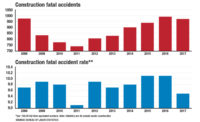The number of construction workplace deaths and the industry's fatality rate declined in 2008, the Bureau of Labor Statistics reported. But the construction sector continues to have the highest number of jobsite deaths among U.S. industries.
The 2008 BLS Census of Fatal Occupational Injuries, released on Aug. 20, shows that construction had 969 fatalities in 2008, down 20% from the previous year's total. The 969 total is the largest among industries. Transportation and warehousing ranks second, with 762 deaths.
The 2008 numbers are preliminary, and will be updated in April.
One likely factor behind the steep decrease in construction deaths last year is that total construction hours worked fell 9.9% from the 2007 level.
But construction's 2008 fatality rate--a measurement that isn't affected by a dip in employment--also declined, to 9.6 per 100,000 full-time equivalent workers, from 10.8 in 2007.
Xiuwen (Sue) Dong, data center director for CPWR--The Center for Construction Research and Training, an affiliate of the AFL-CIO Building and Construction Trades Dept., cites several factors behind the decline: the downturn in the overall construction industry and employment, and fewer workers in the high-risk population in this industry.
More specifically, she says that the center has identified a decrease between 2007 and 2008 of about 17% among Hispanic construction workers, who, the center's studies have shown, "have a higher fatality rate than their non-Hispanic counterparts."
Dong says, "We know that Hispanic workers have traditionally taken low-skilled, high-risk jobs and they also face language barriers on jobsites." She adds, "Therefore, it is rational to believe that the reduction in Hispanic employment in construction contributed to the decline in construction fatalities."
Looking at segments of the construction industry, BLS reported that deaths decreased 21% last year in construction of buildings and were down 14% in heavy and civil construction and 19% among specialty trade contractors.
Across all industries, total fatal workplace injuries in 2008 were down 10%, to 5,071. That is the lowest annual preliminary mark since BLS began its fatal injuries census in 1992.
Labor Secretary Hilda L. Solis says, "While the decrease in the number of fatal work injuries represents change in the right direction, it does not lessen the need for strong enforcement to ensure that safety is a top priority in every workplace."
Final annual numbers for workplace fatalities typically have been higher than the preliminary figures, as more information--such as death certificates, medical examiners' reports and occupational safety and health reports--is filed with BLS.
But the bureau cautions that for 2008, "Budget constraints at some [nonfederal] governmental agencies may have delayed the receipt and processing of the documents that are used by our state partners and classify and code [fatal injury census] cases."
BLS says that over the past two years, the average net increase from preliminary to updated overall fatality totals has been 153 cases. But it adds that "the updated 2008 counts...have the potential to be larger because of these delays."



Post a comment to this article
Report Abusive Comment